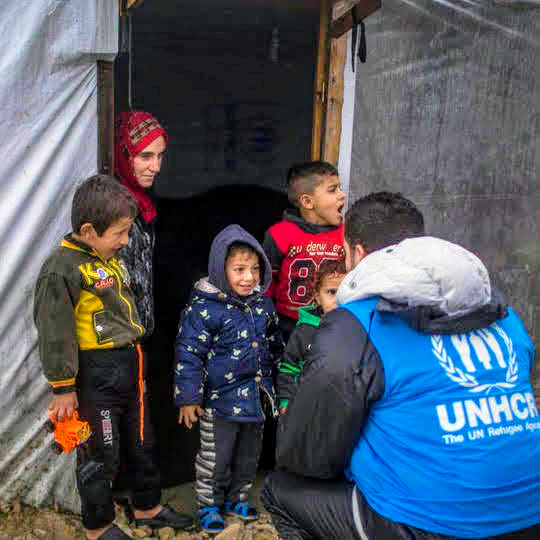Vulnerability Assessment of Syrian Refugees - 2019
Lebanon, 2019
Get MicrodataIdentification
UNHCR_LBN_2019_VASYR_v2.1
Vulnerability Assessment of Syrian Refugees - 2019
| Name | Country code |
|---|---|
| Lebanon | LBN |
The Vulnerability Assessment for Syrian Refugees in Lebanon (VASyR-2019) was conducted jointly by the United Nations Children’s Fund (UNICEF), United Nations High Commissioner for Refugees (UNHCR) and the United Nations World Food Programme (WFP, dataviz.vam.wfp.org). Now in its seventh year, the Vulnerability Assessment of Syrian Refugees in Lebanon (VASyR) assesses a representative sample of Syrian refugee families to provide a multi-sectoral update of the situation and to identify changes and trends. The Government of Lebanon estimates that the country hosts 1.5 million of the 6.7 million Syrians who have fled the conflict since 2011 (including nearly one million registered with UNHCR as of end of September 2019). Survey teams visited 4,727 randomly selected Syrian refugee households, covering all districts across Lebanon. The result of the study demonstrates that while some improvements in specific indicators are noted, Syrian refugees in Lebanon continue to show heightened vulnerabilities. While rates of birth registration have seen an increase since previous years, other legal documentation issues (e.g. legal residency) remains to be an on-going challenge. About half of households are living in extreme poverty, despite large scale assistance programs to families. Additionally, while rent prices were not noted to increase dramatically, many families continue to live in substandard and over-crowded conditions across the country.
Sample survey data [ssd]
Household and individual
Version
v2.1: Edited, cleaned and anonymised data.
Scope
The scope includes:
- key indicators on household demographics
- safety and security
- accomodation
- health
- food security
- livelihoods
- expenditures
- food consumption
- debt
- coping strategies and assistance
- intention to return
- education
| Topic |
|---|
| Food security |
| Livelihood & Social cohesion |
| Basic Needs |
Coverage
National coverage
The sampling frame used for VASyR 2019 was the total number of Syrian refugees in Lebanon known to UNHCR.
Producers and sponsors
| Name |
|---|
| UNHCR |
| WFP |
| UNICEF |
Sampling
The sample includes 4727 Syrian refugee households, and aims to be representative of the Syrian refugee families in Lebanon. A two-stage cluster approach was adpoted using the sampling frame of the total number of Syrian refugees known to UNHCR. Using the "30x7" two stage cluster scheme, originally developed by the World Health Organization, 30 clusters per geographical area and seven households per cluster are used to provide a precision of +/- 10 percentage points. The sampling strategy accounted for the need to generate results that are representative on a district, governorate and national level. As such, districts were considered as the geographical level within which 30 clusters were selected. There are 26 districts in Lebanon, where Beirut and Akkar each represent a district and a governorate. As such, to ensure representativeness of these two districts as governorates, an additional two cluster samples were considered for each.
The primary sampling unit was defined as the village level (i.e. cluster) and UNHCR cases served as the secondary sampling unit. A case was defined as a group of people who are identified together as one unit (usually immediate family) under UNHCR databases. Villages were selected using 'probability proportionate to size, and 30 clusters/villages were selected with four replacement clusters per district.
Data collected through this assessment was weighted at the district level based on the population of refugees in each district. Weighting was necessary to ensure that the geographical distribution of the population was reflected in the analysis and to compensate for the unequal probabilities of a household being included in the sample. The normalized weight was calculated for each district using the following formula:
Normalised weight= (sample frame district/ total sample frame) / (number of houses visited in the district / total number of households visited)
Survey instrument
The questionnaire included key information on household demographics, arrival profile, registration, protection, shelter, WASH, assets, health, education, security, livelihoods, expenditures, food consumption, coping strategies, debts and assistance, as well as infant and young feeding practices.
Data collection
| Start | End |
|---|---|
| 2019-03-08 | 2019-05-03 |
| Name |
|---|
| Caritas |
| World Vision International |
| Makhzoumi Foundation |
| SHEILD |
Separate enumerator trainings were carried out in each operational region (Bekaa, Mount Lebanon, North and South) covering the data collection tool, contextual background, methodology and ethical considerations. The trainings were administered by UNHCR, WFP and UNICEF staff over the course of seven days, including two field test days. Data was collected and entered on electronic tablets by the enumerators during the interviews using Open Data Kit (ODK) software.
Data Access
UNHCR, WFP, UNICEF (2019) Vulnerability Assessment of Syrian Refugees in Lebanon, UNHCR microdata library, https://microdata.unhcr.org
Contacts
| Name | Affiliation | |
|---|---|---|
| Curation team | UNHCR | microdata@unhcr.org |
Metadata production
UNHCR_LBN_2019_VASYR_v2.1
| Name |
|---|
| UNHCR |
